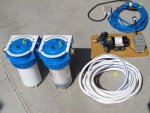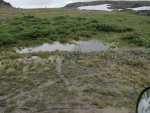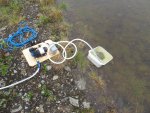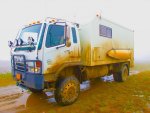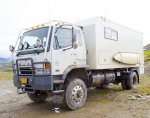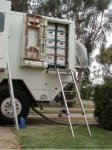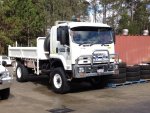Tires & Dual Wheels
...I see that you are running dual wheels. What size rim and tire and what tire "make and model".
Have you felt a need to go to the large Super Singles?
Thanks
Steve4wdaus
Yes, I am running duals in the rear. The rims are 22.5x8.25 in size — sorry, I do not know what the metric equivalent is. Since I have (2) mounted spares, I have 8 rims total:
(4) Accuride 22.5" x 8.25” steel disc, and
(4) Alcoa 22.5” x 8.25” forged aluminum
The aluminum rims were chosen for appearance for the front and outside rear; the less expensive steel are used for inside rears and spares.
The tires I am running are Bridgestone M711, size 22.5-11. They have what I would describe as a moderately aggressive tread, with open side-tread pattern. Bridgestone characterizes them as a “long haul tire”, along with having:
"Deep tread depth for long original mileage. Staggered tread block design distributes forces evenly to resist irregular wear. Aggressive traction pattern for solid grip in rain, mud and snow." (quoted from Bridgestone website)
The diameter of these tires is approx 41", helping me with clearance under my rather large front and rear diffs.
Clearance= front diff 12"
tie rod 13"
tie rod knuckles 10.5"
transfer case 15"
rear diff 10.5"
When I first began with this arrangement I had some concern about both rapid tire wear and perhaps some lack of stability or cornering control in the front end due to the deep lug pattern. So far, NEITHER OF THESE CONCERNS HAS COME TRUE.
At 30,000 miles I have between 56% and 69% of my original tread depth remaining [varying by tire and position; the front having the most wear, as you'd expect.] I have encountered some moderate ‘cupping' of the outside front lugs, but several different truck tire shops have pronounced this as normal due to cornering and steering; rotation to a rear position seems to even everything out pretty well so far. As far as handling, I have never driven another big truck/camper that handled nearly so well. At 23,000# it's no sports car, but I do sometimes push it on winding roads and I have never felt the front end to be mushy or to roll as I definitely have experienced on some other rigs I have owned and driven.
I would highly recommend the tire if available, not cost prohibitive in the local market, and fitting one's weight requirements. I have driven them fairly extensively in snow, sand, and mud, and I absolutely plan to repurchase the same tire when these wear down.
As to ‘super singles': Gosh, I don't want to start a debate or flame war on this subject, but you asked and I will offer my 2-pence worth.
SAND-I have read in lots of places about how dual wheels are not supposed to track and perform as well as in-line singles in sand. I confess, I can't yet understand why more floatation in sand wouldn't be better, but I don't ‘get' lots of things in life [e.g., relativity theory] that apparently are true. At any rate, my driving in relatively deep sand through dry stream beds and moderate desert crossings in our SW have not been a problem for me. However, I admit up front that I cannot attest to how they would do on the deep-brekable-crust of Sahar sand dunes south of the Atlas Mountains — I haven't been there yet.
SNOW-With a light vehicle, I could well understand how the greater surface area of duals could make one float — and skid or spin — in snow, but my vehicle is heavy enough and my tires are narrow enough that, so far, as much a 2' of snow has been absolutely no deterrent. The rig seems to cut down into snow sufficiently to secure adequate traction. I will not attempt to argue that my duals are better than the singles I have driven [(2) EarthRoamers for nearly 80,000 mi], but I will say that I am MUCH MORE RELAXED after a number of hours in snow in the Fuso than in any single-rear-wheel rig I have personally driven, and I have certainly not gotten stuck nor slid off the road with duals.
MUD-Regarding mud, I drove the EarthRoamers with a horse trailer attached thru tens of miles of at least axle-deep mud, never getting stuck; I have not yet had an equivalent mud challenge in the Fuso, so my jury is still out on mud. I am inclined to think that it depends on the mud: if it's truly bottomless one would want floatation, if it has a bottom then one would want a narrow single to reach to the bottom for traction — but that's all conjecture.
Notwithstanding, I am nevertheless somewhat subject to group think. I really wanted to get singles on the rear when I first got the vehicle. The designer/builder refused to put singles on; both Dana Axle [rear axle] and Marmon-Harrington [front axle] refused to warranty the axles if he did so. Both companies claimed it would change the force vectors on the axles and bearings and do damage. 30,000 miles later I feel almost no residual ‘urgency' to do a switch. I just haven't found a situation that justifies/rationalizes it. So, in the interest of honesty, I admit to being vaguely aware of a socio-cultural norm that says that a ‘real' expedition vehicle has single rear wheels. [One of Jung's archetypes?] If I could do a switch for a very modest cost, I would look at it, if for no other reason than curiosity — but in the bigger picture I, for one, am not fretting any purported inadequacy a bit.
Question: do you think the weight of the vehicle may have to be factored into the equation to really understand the value/need of single vs dual rear wheels?
Overall on this subject:
For me the bottom line is with DRW after thousands of miles truly off-road I seem to be able to go where I want to go. This has included open sand desert, sand-gravel washes, raw lava fields, deep gumbo mud while hauling a horse trailer, and most recently this summer driving to the end of the North Canol Road at the NWT boundary where I got hit with 18” of snow on July 8. I began my dual-wheel ownership more than a bit skeptical, but I have not yet actually encountered a problem due to dual-lies, though I certainly am not saying I won't and that others haven't. In winter I do carry chains [state law and insurance], but have never had to put them on 'in anger', only practicing in my driveway. In a week or so I will be heading to the SW to drive snowy passes along with sandy and muddy ‘roads'; I'll report my experience.
10-26-2017 promised update report Nearly 5 years and a lot of miles later, I still have not managed to
actually create a problem with the dual rear wheels. Haven't managed to get a rock in them, nor slide off the road in snow or get bogged down in mud. On the other hand, I will bet that this is less due to any 'prowess' of dual wheels and a great deal more to the advice I remember getting the first time I bought a 4x4 - "John, remember 4 wheel drive can mean you get yourself just as stuck but even farther from rescue." Especially with a 23,000 # rig, I don't drive out onto the bleeding edge very much. I try to drive only as far as I have confidence & experience that I can drive back out under my own power. My moto and my feet are for beyond that.


